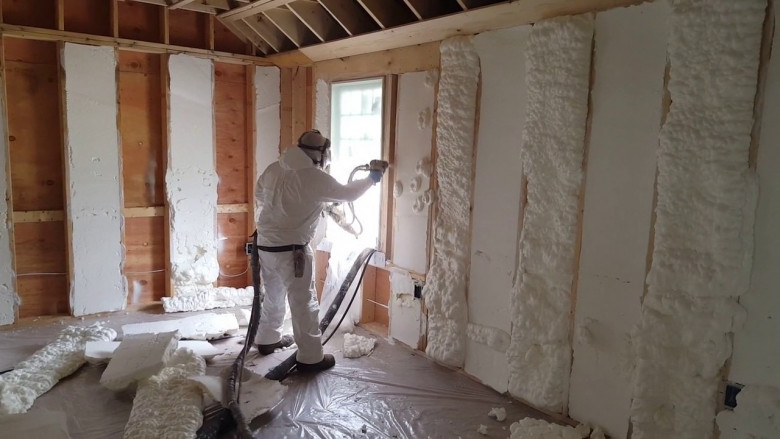Closed-cell spray foam creates an unmatched protective envelope for buildings by combining superior R-value (6.0-7.0 per inch) with exceptional air sealing and moisture resistance capabilities in a single application. Unlike traditional insulation that only addresses thermal resistance, this high-density polyurethane-based material expands to 2-3 times its liquid volume upon application, filling gaps completely and adhering permanently to surfaces to create a seamless barrier that blocks heat transfer, air movement, and water infiltration simultaneously. With compressive strength exceeding 25 psi, it also adds structural integrity to walls and roofing systems.
The material's closed-cell structure contains billions of tiny cells filled with gas and completely sealed from neighboring cells, preventing moisture penetration while providing exceptional thermal performance that remains stable over decades. This comprehensive protection against the elements results in energy efficiency improvements of 25-40% compared to fiberglass insulation, significantly better indoor air quality through prevention of mold growth, and enhanced building durability through structural reinforcement and moisture management. According to Department of Energy data, professional closed-cell spray foam insulation maintain consistent interior temperatures with 30-50% less energy input than those using conventional insulation systems.
Technical Specifications and Performance Metrics
Understanding the technical properties of closed-cell spray foam helps explain its exceptional performance:
|
Property
|
Performance Value
|
Comparison to Fiberglass
|
Comparison to Open-Cell Foam
|
|
R-Value Per Inch
|
6.0-7.0
|
2x higher
|
1.7x higher
|
|
Density
|
1.75-2.25 lb/ft³
|
7-9x denser
|
4x denser
|
|
Water Absorption
|
<4% by volume
|
Significantly lower
|
70-90% lower
|
|
Air Permeance
|
<0.004 L/s/m²
|
Near-complete air barrier
|
10x better air sealing
|
|
Compressive Strength
|
25-30 psi
|
Adds structural strength
|
5x stronger
|
|
Vapor Permeance
|
0.8-1.2 perms
|
Acts as vapor retarder
|
15x less permeable
|
|
Dimensional Stability
|
<9% change
|
Doesn't sag or settle
|
More stable long-term
|
|
Sound Transmission
|
STC 37-45
|
Moderate improvement
|
Similar performance
|
|
Lifespan
|
30+ years
|
10+ years longer
|
5-10 years longer
|
|
Installation Temperature Range
|
40-120°F
|
Wider range
|
Similar range
|
Bonus Tip: When evaluating insulation performance, multiply the R-value by the years of effective service life to determine true lifetime value. Closed-cell foam's combination of high initial R-value and superior longevity provides 2-3 times the lifetime thermal performance of traditional insulation systems.

Applications and Optimal Use Cases
Closed-cell spray foam excels in specific building scenarios where its unique properties provide exceptional value:
|
Application
|
Benefits
|
Limitations
|
Best Practices
|
|
Basements & Crawlspaces
|
Prevents moisture infiltration, eliminates condensation
|
Higher initial cost
|
Apply directly to foundation walls
|
|
Rim/Band Joists
|
Stops air infiltration at critical envelope junction
|
None significant
|
Ensure 2-3" application depth
|
|
Roof Decks
|
Creates unvented attic, protects against ice dams
|
Requires proper ventilation strategy
|
Verify code compliance for unvented assemblies
|
|
Coastal/Flood-Prone Areas
|
Resists water damage, provides structural support
|
Cost premium
|
Apply to full cavity depth
|
|
Metal Buildings
|
Prevents condensation, addresses thermal bridging
|
Special primers may be needed
|
Use hybrid system with thermal break
|
|
Commercial Cold Storage
|
Vapor control, exceptional thermal performance
|
Higher initial investment
|
Design for continuity at junctions
|
|
Critical Facilities
|
Resists extreme weather, adds structural strength
|
Requires professional installation
|
Include in disaster resilience planning
|
|
Historic Renovations
|
Conforms to irregular surfaces, minimal disturbance
|
Irreversible application
|
Test small areas first
|
Market data shows closed-cell foam installations have increased by 18% annually over the past five years, with particularly strong growth in coastal regions where resilience against moisture and high winds delivers substantial value beyond energy savings.
Installation Process and Requirements
Professional installation is essential for closed-cell spray foam due to specialized equipment requirements and the precise mixing needed for optimal performance.
Installation Stages and Considerations
|
Stage
|
Key Requirements
|
Common Issues
|
Quality Control Measures
|
|
Site Preparation
|
40-120°F ambient temperature, <20% substrate moisture
|
Temperature too low, surface contamination
|
Temperature/moisture testing before installation
|
|
Surface Preparation
|
Clean, dry surfaces free of oils and loose debris
|
Inadequate cleaning, missed areas
|
Visual inspection, adhesion testing
|
|
Application
|
2-3" maximum thickness per pass, 15-30 minute recoat window
|
Improper mixing ratio, uneven application
|
Continuous thickness measurements
|
|
Curing
|
24-72 hours curing time with ventilation
|
Premature reentry, inadequate ventilation
|
CO₂ monitoring, moisture content verification
|
|
Trimming/Finishing
|
Removal of overspray, quality inspection
|
Damage during trimming, missed voids
|
Visual inspection, thermal imaging
|
|
Final Inspection
|
Thickness verification, coverage confirmation
|
Inadequate depth, missed areas
|
Core sampling, thermal imaging verification
|























Comments
0 comment